Where to get rid of asbestos and why using a professional is safer for Asbestos Disposal.

The majority of the products manufactured nowadays do not contain asbestos. Those few products manufactured, which still do have asbestos that could be inhaled are needed to be labelled as such. However, until 1970, lots of building products and insulation items utilised in homes had asbestos. The familiar products that may have asbestos in the past as well as conditions that may release fibres include:
• Boilers, furnace ducts and steam pipes insulated with an asbestos paper tape or blanket. These materials may release asbestos fibres should they be repaired, damaged, or improperly removed.
• Flexible floor tiles (asphalt, rubber and vinyl asbestos), the support on vinyl sheet floor covering, and adhesives utilised in fixing floor tiles. Sanding tiles can discharge fibres. So too can scraping or sanding the backing of sheet flooring during removal.
• Cement sheets, mill boards, and paper used as filling around wood burning stoves. Repairing or removing examples of these old appliances may release asbestos fibres. So also may tearing, cutting, drilling, sanding or sawing insulation.
• Sound proofing or decorative materials sprayed on ceilings and walls. Crumbly, loose or water-damaged material may also release fibres. So also will drilling, sanding or scraping the material.
• Patching and joint compounds for ceilings and walls as well as textured paints. Scraping, sanding or drilling these surfaces may likely discharge asbestos.
• Asbestos cement roofing, siding and shingles. These items are likely not to discharge asbestos fibres except drilled, sawed or cut.
• Artificial ember and ashes sold for use in gas-fired hearth. In addition, other older house hold items like ironing board covers, stove-top pads, fireproof gloves and some hairdryers.
• Automobile linings and brake pads, gaskets and clutch facings.
What can be done regarding asbestos disposal in the home?
Do you think asbestos may be in your home? The best thing to do is usually to leave alone the asbestos material that is in good condition. Normally, materials in good condition will not release asbestos fibres. There is no danger unless those fibres are disturbed somehow and released which can be inhaled into the lungs.
Examine regularly any material that is suspected to contain asbestos. Never touch it however, look for indications of wear or damage like abrasions, tears or water damage. Damaged material may release asbestos fibres. This is specifically correct should you disturb it by rubbing, hitting or handling it or if it is opened to severe air flow or vibration.
Occasionally, the ideal way to deal with moderately damaged material is to reduce access to the area let alone touch or disturb it. Discard worn or damaged oven-top pads, asbestos gloves or ironing board covers. You can check with environmental, local health or other suitable officials from your council to discover appropriate handling and disposal methods.
Should the asbestos material be more than moderately damaged, or perhaps you if are going to make changes in your home that might disturb it, a removal or repair by an expert is essential. Prior to having your house renovated, find out if asbestos materials are present.
Major repairs should only be carried out by an expert trained in procedures for safely asbestos handling. Minor repairs should likewise be carried out by skilled personnel as there is always exposure risks to fibres when asbestos are disturbed.
Performing minor repairs yourself is not advisable since improper handling of asbestos materials might create a danger where none existed. However should you decide to perform the minor repairs, ensure you have as much details as possible regarding asbestos handling prior to doing any repair.
Get in touch with your local or state health department or regional EPA office for details regarding asbestos training courses in your area. Your local school district may as well possess information regarding asbestos experts and training programs for school buildings. In the event that you have completed a training program, never try anything other than minor repairs. Prior to undertaking minor repairs, cautiously check out the area around the damaged part to ensure it is stable.
Generally, any damaged area bigger than the size of your hand is no more a minor repair.
If you have any concerns with regards to asbestos at work, or even a residential premises, contact our customer services on 01903 297818 or fill in our contact form and we’ll be able to help you further.
